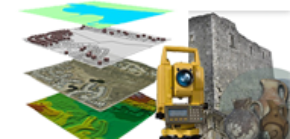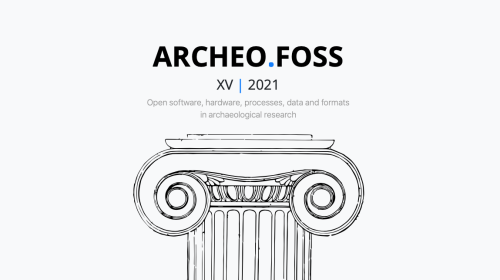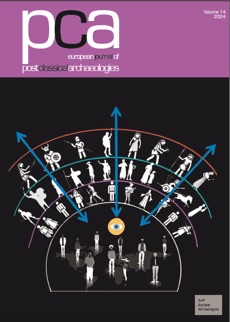CONFERENCE PROGRAMME
Due to the global coronavirus (COVID-19) perdurance, the 15th edition of the International Conference ArcheoFOSS Open Software, Hardware, Processes, Data and Formats in Archaeological Research will be held online on November, 23rd – 26th 2021.
The platform used to stream the conference will be announced soon.
TALKS
23/11/2021
Section 1: GIS
9:30-9:40
Open Source GIS for Colosseum study and management
Elisa Cella1; Fabio Fumagalli2; Pietro Giannini3; Silvia Impinna3; Francesco Laddaga3; Barbara Nazzaro1; Federica Rinaldi1; Jacopo Russo3; Emiliano Tondi3; Martina Almonte1; Simona Morretta4
1Parco archeologico del Colosseo, 2Freelance, 3Poleis scarl, 4Soprintendenza Speciale Archeologia Belle Arti e Paesaggio di Roma.
9:40-9:50
An open source platform addressing structural stability risk assessment in historical centers
Renzo Carlucci1; Charilaos Maniatakis2; Philip Fayad1; Andrea Di Iorio1; Nikolaus Sketakis1; Costantine Spyrakos2; Haris Saroglou2; Alessio Di Iorio1; Alexandros Paraskeuas3; Nikos Papadopoulos4
1Alma Sistemi srl Guidonia (RM) Italy; 2National Technical University of Athens Greece; 3Geosystem Hellas, Greece; 4FORTH Hellas.
9:50-10:00
MO(v)EIT: proof of concept of a road graph for Late Antique Egypt
Julian Bogdani1
1Sapienza University of Rome.
10:00-10:10
Palaeo-landscape feature identification: a FOSS cloud-based Python approach through Google Earth Engine (GEE)
Guillem Domingo-Ribas1; Filippo Brandolini1
1School of History, Classics and Archaeology, Newcastle University, UK
10:10-10:30
Questions and Answers for the 1-4 Talks
PAUSE: 10:30-10:45
Section 2: GIS
10:45-10:55
Qfield, pyArchinit and BraDypUS, interchange of protocols and workflows for academic research
Giuseppe Guarino1; Paolo Rosati2
1Alma Mater Studiorum – University of Bologna; 2Sapienza University of Rome.
10:55-11:05
Using QGIS, Qfield and PyArchinit in the Maasser el-Shouf Archaeological Project (Lebanon)
Silvia Festuccia1; Roberto Montagnetti2; Giovanna Verde3
1University ‘Suor Orsola Benincasa’, Naples; 2ad@Arte; 3Independent researcher
11:05-11:15
From micro-regional to intra-site analysis: the GIS of the Italian Archaeological Expedition in the Erbil Plain (Kurdistan Region of Iraq)
1Valentina Oselini; 2Michael Campeggi; 3Luca Forti; 4Elisa Ginoli; 5Andrea Pezzotta ; 4Luca Peyronel
1Department of humanities, ancient and modern languages, literature and cultures, University of Perugia, Perugia, Italy; 2, 4, 6 Department of Literary Studies, Philology and Linguistics, University of Milan, Milan, Italy; 3, 5Department of Earth Sciences “Ardito Desio”, University of Milan, Milan, Italy; 3Institute of Geosciences and Earth Resources of the Italian National Research Council, Pisa, Italy
11:15-11:25
Un ecosistema digitale per la conoscenza, la conservazione e la valorizzazione del sito archeologico medievale di Satrianum (Tito, PZ). Strumenti FOSS
Giorgia Dato1; Eugenio Saccà2; Alessandro Spadaro3
1Independent Researcher; 2Università degli Studi della Basilicata – Scuola di specializzazione in beni archeologici; 3Università degli Studi di Roma Tre – Facoltà di Architettura
11:25-11:45
Questions and Answers for the 5-8 Talks
PAUSE: 11:45-12:00
Section 3: 3D
12:00-12:10
Virtual Tour realizzato con Pannellum ed integrazione LeafletJS
Martina Frau1; Valerio De Luca1
1Una Quantum inc
12:10-12:20
The Roman Villa of l’Albir (Alicante, Spain). The use of Blender and the Extended Matrix in the virtual recreation
Jaime Molina1; Carolina Frías1; Javier Muñoz1; Laia Fabregat1; Alejandro Martín1; Daniel Tejerina1
1University of Alicante
12:20-12:30
Use of 3D Modelling and Open-Source Programs for Student Research Projects on the Ancient Maya Site of Pacbitun, Belize.
Sheldon Skaggs1,2; Hadja Jalloh1; George Micheletti3; Terry Powis4
1Bronx Community College; 2CUNY; 3University of Central Florida; 4Kennesaw State University
12:30-12:40
Combination of standardised methods to create a detailed source-based reconstruction of the Tepidarium at L’Alcudia de Elche, Alicante, Spain
Cristina Gonzalez-Esteban1
1University of Southampton
12:40-13:00
Questions and Answers for the 9-12 Talks
LUNCH: 13:00-14:00
Section 4: Open Data
14:00-14:10
Using programming environments for academic research and writing
Morgan Lemmer-Webber1,2
1Independent Scholar; 2University of Wisconsin, Madison (PhD conferred May 2021)
14:10-14:20
re3dragon – The archaeological FLOS REsearch REsource REgistry and API for Data Dragons
Florian Thiery1; Allard Mees1
1Römisch-Germanisches Zentralmuseum, Mainz, Germany
14:20-14:30
Epigraphic Database Rome (EDR) towards relational openness: development of the JSON format
Silvia Orlandi1; Saverio Giulio Malatesta2; Lanfranco Fabriani2
1Dipartimento di Scienze dell’Antichità – Sapienza Università di Roma; 2Centro interdipartimentale di ricerca DigiLab – Sapienza Università di Roma
14:30-14:45
Questions and Answers for the 13-15 Talks
PAUSE: 14:45-15:00
WORKSHOPS
24/11/2021
09.00-11.00
Full immersion in Cultural Heritage environments: a new IDEHA for data managing and displaying
Workshop by Luca Bevilacqua1; Bruno Fanini2; Nicola Mariniello1; Augusto Palombini2; Vladimiro Scotto di Carlo1; Antonio Sorgente3; Paolo Vanacore3
1Engineering Ingegneria Informatica S.p.a; 2CNR Institute of Heritage Science; 3CNR Istitute of Applied Science and Intelligent Systems
IDEHA (Innovation for Data Elaboration in Heritage Areas), is a PON project coordinated by CNR, aimed to an open platform for real-time aggregation of Cultural Heritage elements (sites, monuments, etc.) data; and their “packaging” in sets of informations for different targets of outlined public. The main tool conceived for displaying data (spread from different sources: news, digital libraries, IoT, etc.) is an immersive viewer capable to display 360° images and videos, all multimedia inserts html5-compatible, and multi-language audio-sinthesized messages. Such a tool is here presented. It has been planned thanks to the effort of CNR and Engineering, and will be released according to the LGPL, to become a trigger of further initiatives both commercial and free.
11.00-13.00
BDUS4 REST API: programmatic access to bdus4 web databases to build Rich Internet Applications or Desktop apps
Workshop by Julian Bogdani1
1Sapienza Università di Roma
REST APIs are a popular way for data exchange between web apps. Based on JSON, they are extremely easy to consume. Bradypus webDB integrates a secure API to expose the contents of a database through HTTP using JSON. The workshop will focus on a complete overview of this functionality and will introduce the participants to shortSQL, a secure and compact version of SQL used to communicate with BDUS4. The API can be used to build web apps or to consume data on Desktop applications (es. QGIS).
14:00-16.00
Dal Cielo alla Terra fin sulla Carta con pyArchinit
Workshop by Roberto Montagnetti1
1Ad@Arte srl
Il Workshop tratterà di tutto l’impianto di gestione di uno scavo archeologico attraverso QGIS e il suo plugin per l’archeologia Pyarchinit 3. Il partecipante sarà in grado di gestire tutto il processo dall’impianto del rilievo dalla fotogrammetria da drone fino alla relazione stampata. In questo workshop illustreremo infatti come far interagire tra loro più procedure adottate negli scavi archeologici di ricerca o legati all’archeologia preventiva e alle Carte di potenziale archeologico. Vedremo vari metodi di allineamento di più progetti di scavo su un’unica base GIS, come georiferire la stratigrafia, gestire le schede US, periodizzare e raggruppare le US in strutture, generare matrix e tavole composite di fase, fino alla creazione di una relazione.
25/11/2021
09.00-11.00
Wikimedia Italia and ArcheoFOSS, Wikiproject 2021 the meaning and the upload of the ArcheoFOSS 2019-20 articles in Wikibooks
Workshop by Paolo Rosati1
1Sapienza Università di Roma
Wikimedia Italia and ArcheoFOSS have stipulated in 2021 an agreement to publish in ‘Gold OA’ the proceedings of the ArcheoFOSS 2019 and 2020 conferences, for the opening of the articles (texts, citations, bibliographic resources, images) within the platforms of Wiki projects, starting from wikibooks. During the workshop this interesting Wikiproject will be presented, the meaning of the operation, the types of licenses used will be explained and the potential of continuing with such a collaboration for future volumes will be shown.
This will be followed by the practical part of the workshop with the uploading of the articles of the 2019 conference volume in Wikibooks, all the operations will be explained in a very didactic and simple way, everything will be followed by the author of the workshop for ArcheoFOSS and Wikimedia Italia.
11.00-13.00
Encoding and Inputting Ancient Egyptian and Coptic for Further Digitization of Cultural Heritage in the Future
Workshop by So Miyagawa1
1Kyoto Uiniversity
This workshop will first explore the history and current issues of encoding and inputting Ancient Egyptian scripts (Hieroglyphic, Hieratic, Demotic) and Coptic alphabet. Then, the presenter will propose solutions to the problems and show the progress in ongoing projects such as SINUHE the Hierotyper and recent Unicode implementation of control characters for quadrat writings.
14.00-16.00
#MICH, il primo contatto: da pyArchInit a Extended Matrix in Blender per le ricostruzioni 3D di sequenze stratigrafiche
Workshop by Enzo Cocca1; Luca Mandolesi1; Emanuel Demetrescu2; Bruno Fanini1
1AdArte srl; 2CNR ISPC
In questa prima apparizione ufficiale di #MICH, saranno date delle linee guida perché un progetto possa fruire di questo hashtag. Come primo esempio pratico vi faremo vedere i primi due progetti collaborativi #MICH che dialogheranno tra loro attraverso il Matrix stratigrafico per far comunicare pyArchInit verso Extended Matrix. #MICH Modular interconnecting Cultural Heritage suggerisce che un progetto ha delle procedure native per accogliere o esportare dati che vengono raccolti da un altro progetto.
L’obiettivo è quello di dare regole base per cui un software, plugin, add-on ecc.. riceva, elabori e restituisca i dati in modo che possano essere reimpiegati da altri applicativi. Il livello di interoperabilità andrà oltre alla semplice lettura dei dati, ma ci saranno griglie di raccolta, elaborazione e scambio condivise.
26/11/2021
09.00-13.00
Open History Map – Cloud First infrastructure for Digital Humanities
Workshop by Marco Montanari1; Lorenzo Gigli2
1Open History Map; 2University of Bologna
The complexity of the infrastructure behind a project such as Open History Map required an original and cloud-first approach, enabling the optimization of every single aspect of the development as well as the deployment and the usage of the system. For this reason a cloud-first approach was used, trying to harness all the features of the most common FLOS software platforms in order to maximize the quality of the final product.
Open History Map Data Index – Monitoring the quality and coverage of open data of the past
Workshop by Marco Montanari1
1Open History Map
Within our work on OHM we started collecting information about major open datasets available online. The geographic precision as well as the informational quality varies a lot between sources, research teams, projects. These factors brought us to the idea to display this variability with the OHM Open Data Index https://index.openhistorymap.org, where we collect all sources we find and all datasets we import in order to display how the world we are trying to describe is somehow already partial.
Open History Map
Workshop by Marco Montanari1; Lucia Marsicano1; Raffaele Trojanis1; Silvia Bernardoni1
1Open History Map
Open History Map, an open map of the past that was already presented as a concept a few years ago, is now in its first year of functioning infrastructure and collects right now around 150GB of data from around 90 sources. The platform is open in all of its aspects and enables research groups to create new importers for their own open datasets. In addition to that, OHM enables the visualization of “ephemeral” datasets, i.e. representation of vicinity for historical characters and the battles.
14.00-15.00
Direttiva 2019/790/UE e Beni Culturali
Workshop by Piergiovanna Grossi1; Marco Ciurcina2
1Università degli Studi di Verona; 2Studio legale Ciurcina
Il 7 giugno 2021 è scaduto il termine di recepimento della direttiva 2019/790/UE sul diritto d’autore. Il testo della direttiva fa riferimento in diversi punti al “patrimonio culturale” e agli “istituti di tutela del patrimonio culturale”. D’interesse sono gli artt. 3, 6, 8 e l’art. 14, che è destinato a interferire con il diritto ex art. 87 e seguenti della Legge 633/1941 in merito alle riproduzioni dei beni culturali. Il Workshop si divide in due sezioni:
- un’esposizione frontale, mirata a introdurre sinteticamente il contesto legislativo attuale in materia di beni culturali;
- uno spazio di discussione, in cui verranno proposti approfondimenti specifici e in cui i partecipanti saranno invitati a intervenire con domande o osservazioni.
15.00-16.00
Dalla Carta al Sistema Informativo Territoriale Archeologico: il caso di Rubiera (RE)
Workshop by Piergiovanna Grossi1; Alberto Belussi1; Annalisa Capurso2; Sara, Migliorini1
1Università degli Studi di Verona; 2Ministero della Cultura, Soprintendenza Archeologia, Belle Arti e Paesaggio per la città metropolitana di Bologna e le province di Modena, Reggio Emilia e Ferrara
Tra il 2019 e il 2020 è stato sviluppato il Sistema Informativo Territoriale Archeologico di Rubiera, RE (SITARu). Il sistema, implementato tramite software gratuito (PostGIS, Geoserver), è basato sugli standard CIDOC CRM e GeoUML e sul LOD AAT del Getty Institute. Raccoglie i dati archeologici del comune di Rubiera, per un periodo cronologico compreso tra l’Eneolitico e il Medioevo. L’accesso al database avviene tramite interfaccia Web GIS e tramite il protocollo standard WFS (standard OGC). Il Workshop si divide in una sezione archeologica, mirata a illustrare il contesto normativo, storico e topografico del territorio rubierese e a descrivere l’accesso e il riuso dei dati pubblicati sul SITARu e una sezione tecnica, mirata a presentare i software, gli standard e le metodologie utilizzate nella realizzazione del sistema.
Prima sezione: prerequisiti nessuno
- Inquadramento normativo e storico-archeologico del territorio rubierese
- Descrizione del progetto
Seconda sezione:
- La metodologia GeoUML
- Gli standard CIDOC-CRM e OGC
- Il vocabolario AAT
- L’utilizzo dei WFS SITARu tramite QGIS






